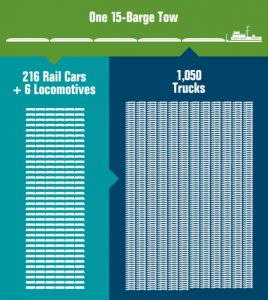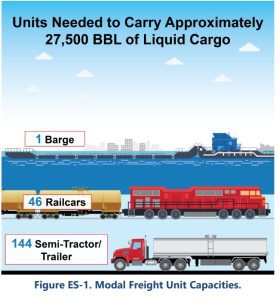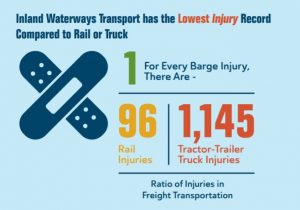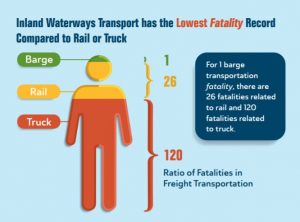ENVIRONMENTAL IMPACTS OF A MODAL SHIFT
Carrying Capacity of Barges Far Outpaces Rail & Trucks

Waterways transport more than 60% of the nation’s grain exports, about 22% of domestic petroleum and petroleum products, and 20% of the coal used in electricity generation. Barges are ideal for hauling bulk commodities and moving oversized or overweight equipment, such as:
- Grain
- Petroleum
- Project Cargoes
- Iron & Steel
- Intermodal Containers
- Chemicals
- Coal
- Aggregates
Liquid cargo carrying capacity by mode:

A report prepared by the Center for Ports and Waterways at Texas A&M for the National Waterways Foundation shows the liquid carrying capacity comparison between modes.
Inland waterways transport has the lowest injury and fatality rates compared to rail or truck.
The Safest Mode for Communities From reducing air pollution to lowering the number of transportation-related injuries and fatalities, inland waterways transport helps to protect people and their environment.
 Safety related statistics for all modes of freight transportation between 2001-2019 show 1 injury in the inland marine sector for every 95.9 in the rail sector and 1,144.6 in the highway sector. 1 fatality in the inland marine sector for every 25.9 in the rail sector and 120.1 in the highway sector.
Safety related statistics for all modes of freight transportation between 2001-2019 show 1 injury in the inland marine sector for every 95.9 in the rail sector and 1,144.6 in the highway sector. 1 fatality in the inland marine sector for every 25.9 in the rail sector and 120.1 in the highway sector.
Highlights of “A Modal Comparison of Domestic Freight Transportation Effects on the General Public: 2001-2019” | October 2021 A study by the Texas Transportation Institute, Center for Ports and Waterways nationalwaterwaysfoundation.org
